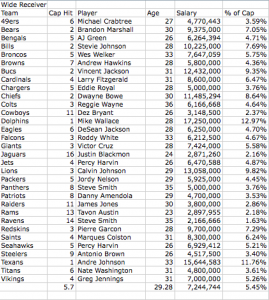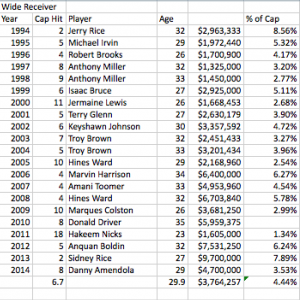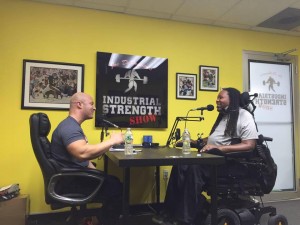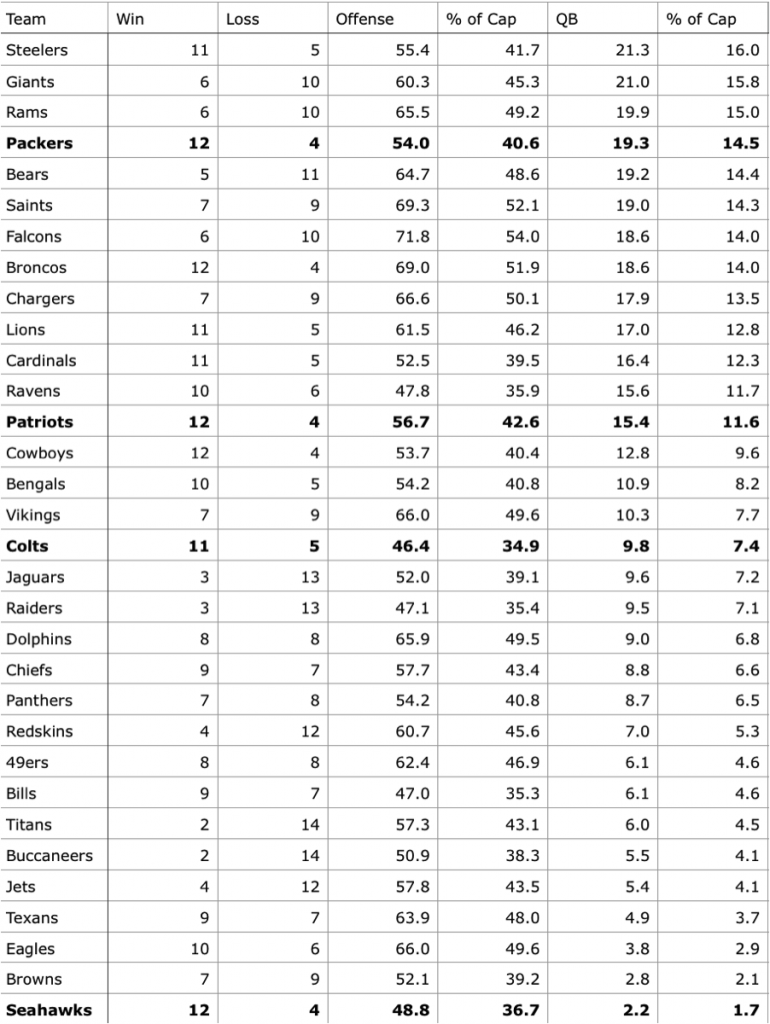Throughout the 2018 off-season, the Bears were in talks for an extension with their 2015 second-round pick out of Florida State, nose tackle Eddie Goldman. Ryan Pace extended one of the players that he was personally responsible for drafting in Chicago for the first time. So far the returns have been positive. Early extensions such as Goldman’s enable teams to have a better understanding of both their roster and salary cap situation for the following offseason before that offseason arrives. Last year the Bears knew they wanted to keep Goldman around. Agreeing to a deal as he was entering the fourth and final year of his rookie contract was the smart decision to move up the timing of his deal before the market increased.
This off-season is no different.
By the numbers
The second-round draft pick at No. 56 overall for the Bears in 2016 was Kansas State interior offensive lineman Cody Whitehair. Like Goldman, the veteran interior lineman is entering the last season of a four-year rookie contract.
At every step of the way during his tenure with the Bears, Whitehair has demonstrated exactly what the Bears were seeking when they drafted him three years ago: versatility and reliability. Whitehair has shifted back and forth between center and left guard multiple times already and has featured well in both spots. He has even handled some duties at right guard in emergency situations. That the veteran has missed only 25 total snaps in three years (per TheQuantEdge), demonstrates just how dependable of a player he is.
Pro Football Focus deemed Whitehair’s rookie season third-best among all centers since they began recording statistics in 2006. Here is what the analytics database had to say about Whitehair’s second season in 2017:
“Though tasked with playing guard to the tune of 259 offensive snaps last season, Whitehair still predominantly played center and played extremely well at the position in 2017. Whitehair ranked fifth in run-block grade (81.8) and fourth in run-block success percentage (17.6) in 2017.”
Whitehair was not only PFF’s third-highest-graded center in 2016, he was No. 13 in 2017, and No. 10 in 2018. At the initial peak of his accomplished career, he allowed a grand total of zero sacks and zero QB hits in 2018. This was while playing every offensive snap.
Run blocking may have suffered a bit for the whole Bears’ offensive line unit in 2018, which will have to be mitigated in coming years. But it was Whitehair and the Bears’ collective pass protection that took a major leap forward.
Here was PFF’s review of the whole season for the big men up front in Chicago:
“The Bears finished the season with the league’s second-best pass blocking efficiency of any offensive line, and this was yet another team without a real weak link. Rookie James Daniels ended up earning their lowest grade at 62.3 overall, but Charles Leno Jr., Bobby Massie, and Cody Whitehair were all over 70.0.”
All of these accolades are great, which brings up an important query: why are the Bears moving Whitehair to left guard after he was one of the NFL’s premier centers (according to at least one metric) in the last three years? It’s a multi-faceted answer.
First, James Daniels is the more natural center, as it was his college position. Second, Whitehair struggled mightily with shotgun snaps in 2018. Matt Nagy utilized the shotgun formation on 79 percent of all offensive snaps in 2018, which was tied for the second-highest percentage in the NFL. The Bears cannot afford to be stressing over quality shotgun snaps. It should be a routine exchange and the more natural center in Daniels gives them that drilled regimen.
What’s most important in Whitehair’s position shift is getting the rest of the Bears’ offensive line to ascend. PFF had complements for Charles Leno Jr. and his run blocking, but the rest of the big boys struggled mightily. Pairing Whitehair and Leno Jr. together on the left side is a calculated decision from Nagy, Pace, and offensive line coach Harry Hiestand. Tarik Cohen and David Montgomery are elite change-of-direction running backs who need space to work with before they can create magic out of thin air. Thanks to the presence of these two dynamic backs, I expect there to be a heavy usage of counters and cutbacks to the left side behind Leno Jr. and Whitehair.
Taylor Gabriel and Cordarrelle Patterson running jet sweeps from the right side to the left should also be a feature of the Chicago offense in 2019. According to SharpFootball’s 2019 NFL preview, the Bears ran the ball behind the center and to the left more than they did to the right in 2018. This may have had something to do with Kyle Long’s absence. An understandable point considering Long’s proficiency as a bruiser in the running game. But I see this trend continuing, and perhaps expanding, in 2019.
While purely speculative, one can also assume that the Bears did not want to put too much on James Daniels’ plate in Year 1. It’s difficult enough to be a rookie in the NFL. If Daniels also had to learn all of the cadences and snap counts of a brand-new offense (along with quarterback Mitchell Trubisky), it could have been a disaster. The shift from center to left guard for Cody Whitehair and vice versa for James Daniels in 2019 makes plenty of sense, and better suits both of their skill-sets long term.
Now what effect does moving Whitehair from center to left guard have on his contract? Many seem to believe that left guards get paid significantly more than centers, but that is not the case.
Below is a table with the top-five free agent contracts in each off-season based on average per year for both left guards and centers:
Top Five Free Agent Signings by APY
As you can see above, only in 2018 did the top-five contracts at left guard have a higher average APY than those at center. This is primarily a result of somewhat of an outlier of a contract – Andrew Norwell’s $13,300,000 per year free agent deal with the Jaguars. Norwell may have proven to be a cautionary tale for teams looking to extend their guards to big deals: he missed five games in 2018 and did not play particularly well in the other 11. In the 2019 free agency cycle, Rodger Saffold, another second-round draft pick and perhaps the best comparison to Whitehair’s situation, was the only left guard to top $7,000,000 APY. However, Mitch Morse, Maurkice Pouncey, and Matt Paradis all topped the $9,000,000 mark at center, and technically these are Whitehair’s cohorts of the past three seasons.
Saffold received an overall PFF grade of 73.2 in his 2018 season with the Rams, compared to Cody Whitehair’s 70.4. A discrepancy that small doesn’t mean a great deal, both were good players last year. Whitehair has the benefit of youth, as he is just 27-years-old whereas Saffold is 31.
If we look at the centers specifically, Morse is 27 and Paradis is 29. Two guys more relatable in age to Whitehair. They also played the same position as the Bears’ interior swingman the past few seasons. That makes them a potentially better gauge of his true market, even though he is sliding over to left guard for 2019.
Morse was drafted No. 49 overall in the 2015 draft, one year before Cody Whitehair was selected at No. 56. Morse played out his rookie contract with the Chiefs and became an unrestricted free agent this off-season. While Morse did play at a high level when healthy, he missed five games in 2018 after missing nine games in 2017. There are some concerns about his concussion history, as he has already been diagnosed with three, and he remains in the Bills’ concussion protocol as of today, August 21st.
Paradis, meanwhile, is a journeyman center that was selected in the sixth round in 2014 and eventually placed on the Broncos’ practice squad. He became a UFA in 2019 after playing on a second-round RFA tender for $2.914 million in 2018. Paradis also missed seven games in 2018, though he hadn’t missed a snap in three years prior to that. Managing a PFF grade of 79 was all the more impressive in a shortened 2018 season.
Below is a table with each of the four player’s PFF grades since 2016:
PFF Grades
While PFF grades are not the end-all be-all authority on player effectiveness, this table demonstrates the type of impact that draft pedigree can have on contract negotiations. Paradis is the only player taken later than the second round. Though he grades out better than the other three players above, he will have received the smallest contract of the group. On the opposite end of the spectrum, I believe Whitehair will come out with the largest contract of his peers.
The largest APY signing at left guard in 2018 was Norwell with the Jacksonville Jaguars. Norwell was an undrafted free agent with the Panthers and played on a RFA tender in 2017 before agreeing to terms in Jacksonville. It should be noted that the Jaguars went on a spending spree in 2018, shelling out the fourth-most cash in the league. Norwell’s three-year PFF grade average prior to 2018 was a 79.37. Norwell’s $13.3M APY extension under the 2018 salary cap equates to $14,125,620.80 APY under the 2019 salary cap. Norwell received $30 million fully guaranteed at signing out of a $66 million total, which is roughly 45 percent. Rodger Saffold, Mitch Morse, and Matt Paradis all received similar guaranteed-at-signing percentages of around 45 percent.
While Ryan Pace, Joey Laine and Co. have presumably attempted to negotiate a lower number by offering the extension a year early (a la Jaylon Smith in Dallas), Whitehair’s camp is still probably looking for top dollar. Pace had no problem making Eddie Goldman one of the highest-paid defensive tackles in the NFL last off-season after his third season. Expecting anything but a similar contract at left guard for Whitehair may be foolhardy. The goal for the Bears’ front office at this point should be to just keep the eventual number below Norwell’s.
Whitehair’s contract projection:
Four years, $49 million ($12.25M APY), $22.5 million fully guaranteed at signing ($14.5 million signing bonus, $1.5 million 2019 base salary, $3 million 2020 base salary, $3.5 million 2020 roster bonus).
In this deal, there will also be a 2021 roster bonus of $3.5 million guaranteed for injury only at signing. The roster bonus will become fully guaranteed on the third day of the 2021 league year. Whitehair is currently due a $1,026,078 base salary in 2019 and the remainder of his rookie contract signing bonus is for $318,103.
Below is a table with the full contract details, including a small $473,922 pay-bump to his 2019 base salary that becomes fully guaranteed:
Whitehair has too many positives working in his favor to not receive a strong, secure contract extension. He’s 27, a former second-round draft pick, extremely dependable and reliable, and capable of playing at a high level at multiple positions. The change of position in the contract year muddles negotiations a bit, but the left guard and center market are still pretty similar.
This projection is a very nice payday for Whitehair, especially when considering that the extension is a year early as he enters the fourth year of his rookie deal. For comparison’s sake, Jaylon Smith of the Dallas Cowboys just became the fourth highest paid inside linebacker (based on APY) in the NFL after starting just 22 games since being drafted in the second round of the 2016 draft (at No. 34 he went 22 picks ahead of Whitehair). As I mentioned at the top of the article, Cody Whitehair has missed only 25 snaps in his three year career out of a possible 3,073… Jaylon Smith has missed 26 starts out of a possible 48. The inside linebacker and interior offensive line market have nothing to do with each other, but consistency brings huge value, particularly to a position that relies on the unit to develop chemistry.
Whitehair becoming the fourth highest paid left guard/center in terms of APY would mean his APY falls around $11 million. This estimate of $11 million APY was essentially where my Whitehair projection began, but the more I dove into the (scarce) resources available to determine Whitehair’s market, the more that number moved upward.
All of the Bears’ moves to clear cap space prior to the 2019 free agency period and most recently with Charles Leno Jr. were not for naught, as another draft pick will be rewarded before the 2019 season kicks off. This hypothetical move will take up roughly $3.4 million in 2019 salary cap space, lowering the Bears’ number to around $18 million (per the NFLPA Public Salary Cap report dated 8/21/2019)






